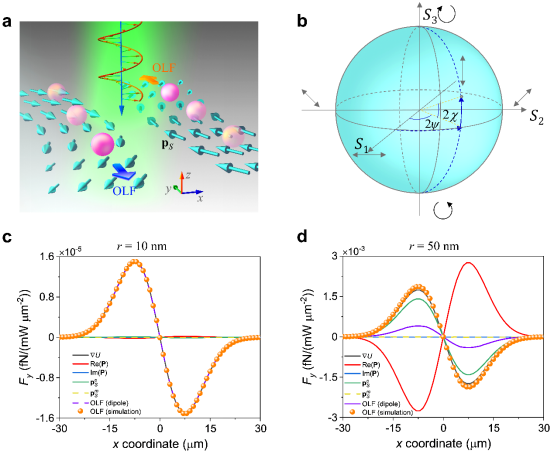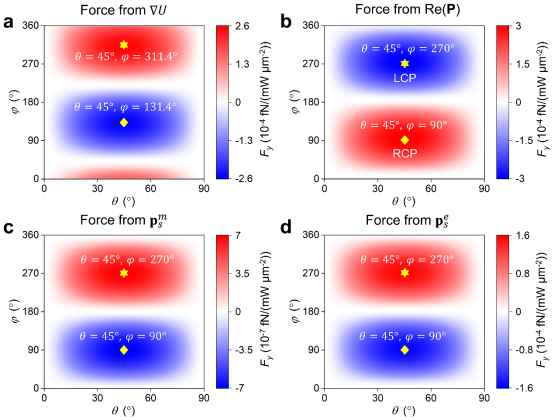Recently, Professor Yuzhi Shi from team of Professor Zhanshan Wang and Professor Xinbin Cheng at the School of Physical Science and Engineering, Tongji University, discovered special properties of optical lateral forces by scanning the entire Poincaré sphere. He found that the polarization state corresponding to the maximum total lateral force is related to the size and refractive index of the particles and is not necessarily located at circular polarization as previously recognized. The research results were published in ACS Photonics under the title of "Mapping optical lateral forces on the Poincaré sphere".
Light carries momenta that can be transferred to matter, generating optical forces. Optical lateral forces (OLFs) refer to optical forces that are perpendicular to the propagation direction of light and are independent of the intensity and phase gradient of the light. OLFs have significant potential for applications in nano-precision sorting, chiral enantioselective separation, and detection of minor momentum. Exploring how polarization state affects OLFs is crucial for achieving the applications.
OLFs typically include forces from Belinfante spin momentum (BSM), imaginary Poynting momentum, and Poynting momentum. The total force acting on particles perpendicular to the propagation direction of light, including OLFs, the optical gradient force and radiation pressure, can be termed as the total lateral force. When the polarization state of light changes, the value and direction of each force will vary, and changes of the total lateral force are the result of the combination of all forces. Existing researches often emphasize one of the largest forces while neglecting the combined effects of other forces.

Figure 1. Mapping the total lateral force on the Poincaré sphere
The research uses a focused elliptically polarized light beam, shaped into a line, to generate the total lateral force on particles. The propagation direction of light is along -z direction, and the total lateral force is along y direction. On each side of the beam, the BSM directions are opposite, leading to opposite directions of the total lateral force (Figure 1a). Points on the Poincaré sphere represent different polarization states, and the entire surface of the Poincaré sphere can represent all polarization states (Figure 1b). To analyze the physical mechanism of the total lateral force, the total force is decomposed into forces from BSM (pS), imaginary Poynting momentum [Im(P)] and Poynting momentum [Re(P)], and the optical gradient force (∇U). At a radius of 10 nm, the optical gradient force dominates the total lateral force (Figure 1c). At a radius of 50 nm, forces from Poynting momentum and BSM also make significant contributions (Figure 1d).

Figure 2. Different types of optical forces under the dipole approximation
The maximum values of the total lateral force from BSM (pS) and Poynting momentum [Re(P)] are located at circular polarization (Figures 2b, 2c, and 2d), but correspond to different left- and right-handed circularly polarized light. The maximum optical gradient force (∇U) is located at elliptical polarization (Figure 2a). This indicates that the optical gradient force and the interaction of different forces cause the maximum total lateral force to appear at elliptical polarization.

Figure 3. The total lateral force for particles of different sizes and refractive indices
Since all parts of the total lateral force are related to the polarization state of light and the electric and magnetic polarizabilities of particles, the polarization state corresponding to the maximum total lateral force is affected by the sizes and refractive indices of particles. At both minor radius and refractive index, the optical gradient force has a majority contribution to the total lateral force, and the polarization state corresponding to the maximum total lateral force is very close to that corresponding to the maximum optical gradient force, which is elliptical polarization (Figures 3a, 3c). As the particle radius increases, the contribution of forces from BSM and lateral energy flow gradually increases, leading to the polarization state corresponding to the maximum total lateral force (φ-Fmax) first approaching to 270°, and then tending towards 90°/450° (Figure 3b). The research shows that the variation in the total lateral force is mainly the result of the combination of the optical gradient force, and forces from BSM and Poynting momentum, with their maxima corresponding to different polarization states. This research demonstrates the importance of combining different forces in optical manipulation, reveals a novel method of utilizing optical forces in a full-polarization manner, and provides new insights into exploring light-matter interactions.
Xinbin Cheng (professor from Tongji University), Yuzhi Shi (professor from Tongji University), and Lingyun Xie (postdoctoral researcher from Tongji University) are the corresponding authors of the paper. Yuchen Zhu (Ph.D. student from Tongji University) and Sha Xiong (associate professor from Central South University) are the co-first authors. Other authors with significant contributions include Professor Zhanshan Wang, Associate Professor Zeyong Wei, Ph.D. students Chengxing Lai, Chengfeng Lu, Hong Luo, and undergraduate student Yujiang He from Tongji University, Associate Professor Qinghua Song from Tsinghua University, and Associate Professor Pin Chieh Wu from National Cheng Kung University in Taiwan.
Paper link: https://doi.org/10.1021/acsphotonics.4c00666
